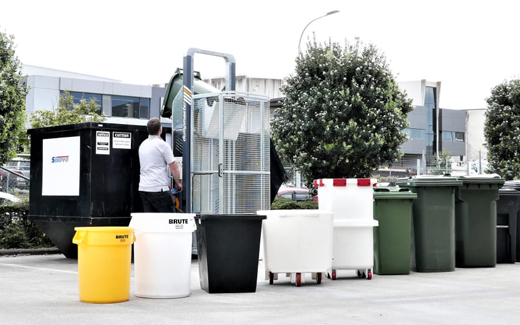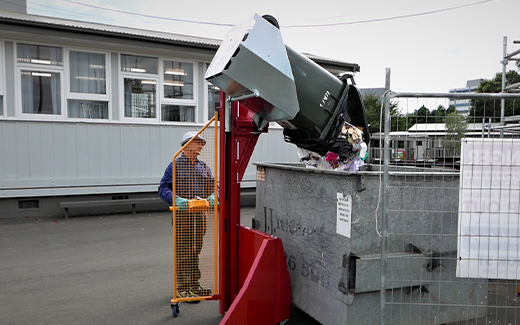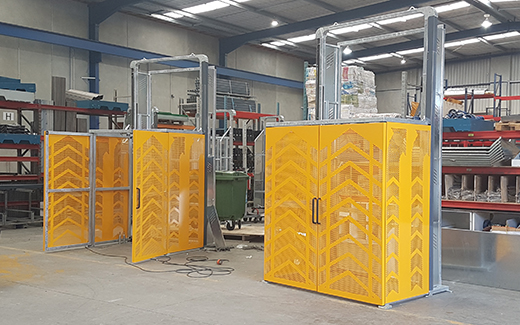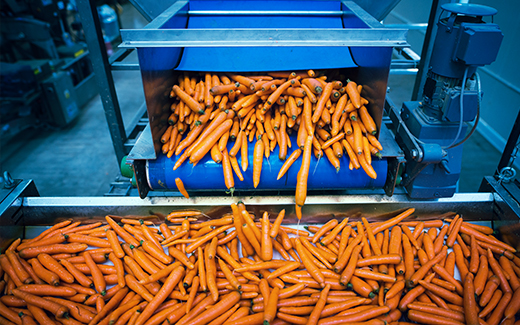When it comes to waste management, the safety of your team should never be left to chance. Bin lifters and other lifting equipment have become everyday tools on construction sites, warehouses, and industrial facilities, but with that convenience comes responsibility.
UK regulations like LOLER, PUWER, and the Supply of Machinery (Safety) Regulations 2008 exist to protect workers from unnecessary risks. They ensure equipment is safe, reliable, and fit for purpose.
At Simpro Europe, we understand what’s at stake. That’s why our bin lifters are designed not just to meet the required safety standards, but to go beyond them. Because when people’s well-being is on the line, “good enough” simply isn’t good enough.
Smart equipment design that prioritises safety
Safe waste handling starts with well-designed equipment. Bin lifters should not only lift bins efficiently but also protect the people using them. They make daily tasks easier, safer, and more comfortable for workers. Here’s how smart equipment design helps reduce risks on-site:
Ergonomic build
Operator safety starts with ergonomic design. High-quality bin lifters incorporate low rolling resistance wheels, smooth handles, and rounded edges to minimise fatigue and musculoskeletal injuries, aligning with HSE guidelines. These features are critical for repetitive tasks, reducing strain and enhancing productivity.
Secure lifting attachments
Advanced locking mechanisms and anti-slip features are standard in our modern bin lifters, ensuring load stability even in busy or uneven environments. These systems prevent slippage and maintain control during lifting operations.
Integrated safety enhancements
Modern bin lifters often incorporate features to enhance situational awareness for both operators and pedestrians. These features contribute to a safer working environment and help reduce the risk of accidents.
Safe clearance & impact prevention
Modern bin lifters incorporate adequate ground clearance in their design to prevent potential foot injuries. Their interfaces are designed to minimise the risk of crushing or shearing hazards when used with other equipment. This often involves adhering to relevant safety standards.
Operational best practices for safer material handling
Safety isn’t just about equipment design, it’s also about how that equipment is used. Here are a few best practices on-site where the use of our bin-lifters help prevent injuries, reduce downtime, and maintain a safe working environment:
Mechanical assistance
Automating lifting and tipping processes reduces manual handling risks, shielding workers from heavy loads and repetitive strain injuries. It is a key focus of the Manual Handling Operations Regulations 1992.
Load management
Balanced loads are essential to prevent tipping or equipment strain. Simpro’s well-designed lifters ensure even weight distribution, minimising spillage and workplace accidents.
Site adaptability
Bin lifters must perform reliably in diverse conditions, such as wet surfaces, slopes, or crowded yards. Simpro’s robust designs include heavy duty castor wheels and dual footbrake for safe operation in challenging environments.
Workforce training & workplace procedures
Even the safest equipment needs trained operators and clear procedures. Proper training and proactive risk management ensure bin lifters are used correctly, reducing accidents and improving site safety. Here are the key workforce practices that support safer operations:
Ease of use
Simpro designs its equipment for ease of use, with intuitive controls and clear safety features that make day-to-day operation simple and efficient, even in demanding environments. Training ensures safe handling, and the simplicity of the system supports productivity.
Defined operating zones
Clear lifting zones, pedestrian exclusion areas, and shutdown protocols prevent accidents involving moving parts or tipping bins.
Proactive hazard management
Regular risk assessments identify site-specific hazards like uneven terrain or overloading, enabling timely mitigation strategies.
Ongoing monitoring
Supervision and audits ensure operators adhere to safety protocols, maintaining compliance with regulations and company policies.
Key UK regulations governing bin lifters
Using lifting equipment safely means following the law. These UK regulations set the rules to ensure bin lifters are safe, properly maintained, and correctly operated. Here’s a quick overview:
Health and Safety Executive (HSE)
The UK’s primary regulator for workplace health and safety, focused on preventing work-related injuries, illnesses, and fatalities. HSE provides regulations, guidance, and research to ensure safe practices, especially in bulk material handling.
Health and Safety at Work Act (HSWA)
The Health and Safety at Work etc. Act 1974 is the UK’s primary safety law. It requires employers, employees, and the self-employed to establish safe systems, provide training, and supervise operations involving heavy machinery and bulk materials.
Provision and Use of Work Equipment Regulations (PUWER)
PUWER 1998 mandates that all workplace equipment be fit for purpose, regularly inspected, and maintained. Only trained personnel may operate machinery, which must include protective devices, controls, and clear warnings to prevent malfunctions and injuries.
Lifting Operations and Lifting Equipment Regulations (LOLER)
LOLER 1998 governs the safe use of lifting equipment. It demands appropriate selection, secure installation, and periodic examinations of lifts, ensuring only competent operators handle high-volume bulk lifting tasks.
Additional measures to safeguard workers
Beyond equipment and training, extra safety steps help protect staff. From wearing the right gear to staying alert and using clear signals, every detail counts in creating a safer work environment. Here are the extra safety steps that can further protect staff:
Essential PPE
High-visibility clothing, steel-toe boots, and gloves form the first line of defence against injuries.
Health monitoring
Regular wellbeing checks help detect fatigue or strain, ensuring operators remain alert and fit for duty.
Emergency features
Clearly marked emergency stop mechanisms allow immediate halting of operations during malfunctions.
Enhanced visibility
Auditory alarms, blue safety lights, and motion sensors, recommended by the Waste Industry Safety and Health (WISH) Forum, alert workers to equipment movements.
Simpro Europe: Raising the bar in safety
Simpro goes beyond basic compliance to deliver safety-first solutions. With smart engineering, full certification, staff training, and ongoing maintenance support, our equipment helps businesses create safer, more efficient worksites.
Thoughtful engineering
Simpro’s lifters are not just compliant — they’re forward-thinking. Features like automatic locking systems, anti-tip mechanisms, and ergonomic design reflect a deep commitment to safety.
Fully certified
Each machine undergoes stringent testing and meets or exceeds UK and EU safety requirements. Certification is provided with every unit for peace of mind and legal compliance.
Training support
Simpro partners with businesses to provide training materials and operational support, helping staff operate machinery with confidence and competence.




